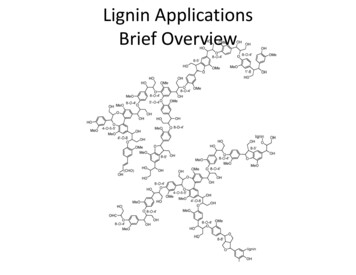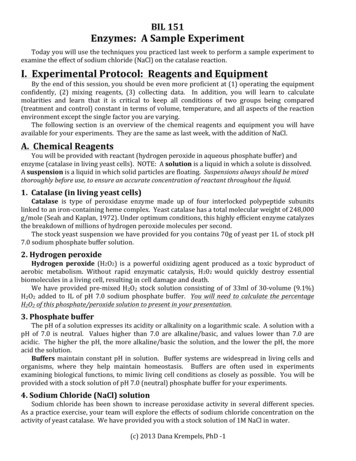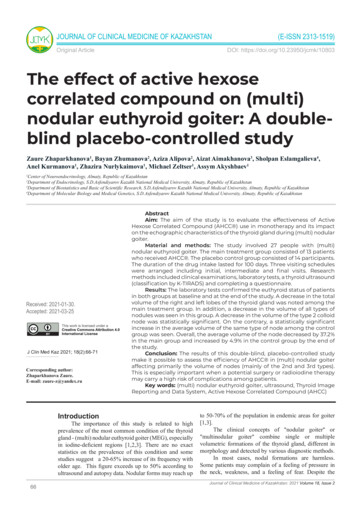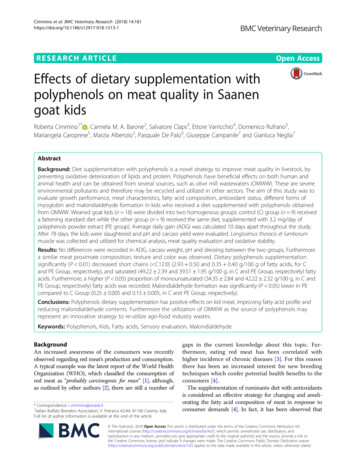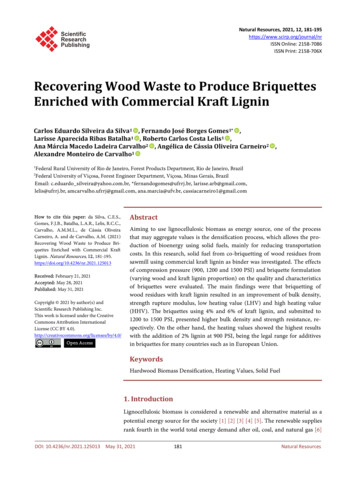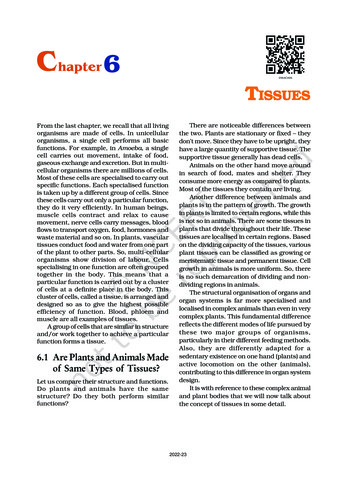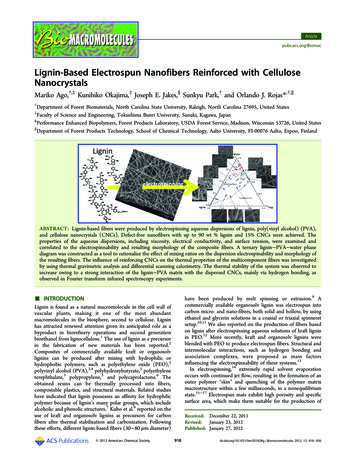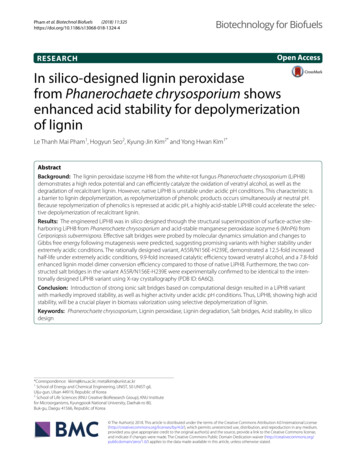
Transcription
(2018) 11:325Pham et al. Biotechnol iotechnology for BiofuelsOpen AccessRESEARCHIn silico‑designed lignin peroxidasefrom Phanerochaete chrysosporium showsenhanced acid stability for depolymerizationof ligninLe Thanh Mai Pham1, Hogyun Seo2, Kyung‑Jin Kim2* and Yong Hwan Kim1*AbstractBackground: The lignin peroxidase isozyme H8 from the white-rot fungus Phanerochaete chrysosporium (LiPH8)demonstrates a high redox potential and can efficiently catalyze the oxidation of veratryl alcohol, as well as thedegradation of recalcitrant lignin. However, native LiPH8 is unstable under acidic pH conditions. This characteristic isa barrier to lignin depolymerization, as repolymerization of phenolic products occurs simultaneously at neutral pH.Because repolymerization of phenolics is repressed at acidic pH, a highly acid-stable LiPH8 could accelerate the selec‑tive depolymerization of recalcitrant lignin.Results: The engineered LiPH8 was in silico designed through the structural superimposition of surface-active siteharboring LiPH8 from Phanerochaete chrysosporium and acid-stable manganese peroxidase isozyme 6 (MnP6) fromCeriporiopsis subvermispora. Effective salt bridges were probed by molecular dynamics simulation and changes toGibbs free energy following mutagenesis were predicted, suggesting promising variants with higher stability underextremely acidic conditions. The rationally designed variant, A55R/N156E-H239E, demonstrated a 12.5-fold increasedhalf-life under extremely acidic conditions, 9.9-fold increased catalytic efficiency toward veratryl alcohol, and a 7.8-foldenhanced lignin model dimer conversion efficiency compared to those of native LiPH8. Furthermore, the two con‑structed salt bridges in the variant A55R/N156E-H239E were experimentally confirmed to be identical to the inten‑tionally designed LiPH8 variant using X-ray crystallography (PDB ID: 6A6Q).Conclusion: Introduction of strong ionic salt bridges based on computational design resulted in a LiPH8 variantwith markedly improved stability, as well as higher activity under acidic pH conditions. Thus, LiPH8, showing high acidstability, will be a crucial player in biomass valorization using selective depolymerization of lignin.Keywords: Phanerochaete chrysosporium, Lignin peroxidase, Lignin degradation, Salt bridges, Acid stability, In silicodesign*Correspondence: kkim@knu.ac.kr; metalkim@unist.ac.kr1School of Energy and Chemical Engineering, UNIST, 50 UNIST‑gil,Ulju‑gun, Ulsan 44919, Republic of Korea2School of Life Sciences (KNU Creative BioResearch Group), KNU Institutefor Microorganisms, Kyungpook National University, Daehak‑ro 80,Buk‑gu, Daegu 41566, Republic of Korea The Author(s) 2018. This article is distributed under the terms of the Creative Commons Attribution 4.0 International License(http://creat iveco mmons .org/licen ses/by/4.0/), which permits unrestricted use, distribution, and reproduction in any medium,provided you give appropriate credit to the original author(s) and the source, provide a link to the Creative Commons license,and indicate if changes were made. The Creative Commons Public Domain Dedication waiver (http://creat iveco mmons .org/publi cdoma in/zero/1.0/) applies to the data made available in this article, unless otherwise stated.
Pham et al. Biotechnol Biofuels(2018) 11:325BackgroundDepolymerization and utilization of lignin are essentialsteps in carbon recycling in terrestrial ecosystems. Conversion of lignin into value-added chemicals is a hot topicin the biorefinery field, which drives further developmentof lignin degradation processes using chemical, biologicaland biochemical catalysts [1].An efficient, natural process for the accelerated degradation of lignin has been developed by white-rot fungithat belong to Basidiomycetes [2]. To efficiently degradelignin, white-rot fungi evolved unique ligninolytic peroxidases, such as manganese peroxidase (MnP), ligninperoxidase (LiP) or the versatile peroxidase (VP), showing unique characteristics, such as mediator utilization and surface-active sites to increase redox potential.LiPs and VPs can directly oxidize nonphenolic lignincompounds through surface-active sites [3, 4]. Notably,lignin peroxidase isozyme H8 (LiPH8) from the whiterot fungus Phanerochaete chrysosporium directly interacts with lignin macromolecules, a finding which wassupported by kinetic analysis of its binding affinity [5].However, quantitative detection of phenolic products ora significant decrease in lignin molecular weight has notbeen reported for in vitro depolymerization of lignin byLiPH8. It is thought that repolymerization of degradedlignin fragments may spontaneously occur, which couldpose a barrier to in vitro depolymerization. In the oxidative depolymerization of lignin, one of the challenges isto control the reactivity of oxygen-based radical species,thereby limiting the problem of recombination/repolymerization of lignin fragments. The pH of the reaction isone of the routes for addressing this problem [6, 7]. In theculturing of P. chrysosporium, the production of organicacids resulted in a pH below or equal to pH 2, which iscritical for in vivo degradation of lignin [8]. Therefore,the poor acid stability of native LiPH8 is believed to hamper effective in vitro depolymerization of lignin. Activeand acid-stable LiPH8 is, thus, urgently required. Workto engineer other ligninases, such as MnPs and VPs, foracidic stability has been reported [7]. However, there areno reported studies of LiPH8, even though LiPH8 has thestrongest oxidation power for the depolymerization oflignin.The conformational stability of a protein is vital to itsfunction and can be affected by noncovalent interactions, such as hydrogen bonds and salt bridges [9–11].Although disulfide bonds contribute increased structural stability to folded proteins at optimal temperaturescompared to that contributed by noncovalent interactions, however introducing artificial disulfide bridgeshas occasionally resulted in protein aggregation owing tooxidation-induced intermolecular disulfide bonds [12]. InPage 2 of 13some cases, salt bridges can be key interactions for sustaining the structure of a protein, such as disulfide bonds[13]. The impact of a salt bridge on the structure of a protein strongly depends on its relative location, orientationand distance between interacting residues, which makesdesigning a salt bridge network to increase protein stability challenging.Evolution of MnPs into LiPs parallels the removal of Mn2 binding sites and the creation of surface tryptophan residues, which accelerates interaction with thebulky structure and oxidation of high-redox-potentialsubstrates, such as lignin [14]. Note that this evolution might unexpectedly result in poor acid stability of the modern LiP. It was also found that variouswhite-rot fungi, such as P. chrysosporium [15, 16],Trametes sp. [17–19], Coriolopsis byrsina, Phellinusrimosus and Lentinus sp. [19] possess LiP isozymeswhich are not stable under extremely acidic conditions (e.g., pH values lower than pH 3.0). Eventhough LiPs and MnPs share a similar overall structure, as both belong to members of the peroxidasefamily, MnPs found in fungi, such as Ceriporiopsissubvermispora and Pleurotus ostreatus, exhibit relatively higher stability under acidic pH conditions [7,20]. MnP6 from C. subvermispora is exceptionallyresilient, as it can retain its activity under extremelyacidic conditions, such as pH 2.0 [4]. Four of the fivedisulfide bridges in MnP6 are conserved in the LiPH8structure. There is an extra disulfide bridge that canstabilize the extraordinarily long C-terminus of MnP6(i.e., when compared with other ligninases). We concluded that the considerable acid stability observedcould be a result of several noncovalent interactions,such as salt bridges and hydrogen bonding networks.Moreover, these kinds of interaction could help tomaintain protein conformation even at high concentrations of protons [20].In this study, we proposed an in silico-based strategy to design active LiPH8 variants for increased stability in intensively acidic environments. Introductionof new strong salt bridges at effective locations andoptimized interactions between charged residues andtheir environments were vital for active and stable LiPat acidic pH. Probing for existing noncovalent interactions, especially salt bridges, using a molecular dynamics (MD) simulation of the solvated structure underthe desired conditions and calculating the Gibbs freeenergy of the variant were valuable tools for creatingan acid-stable LiP variant. Protein X-ray crystallography was also employed to verify the existence of thedesigned salt bridges introduced between interactingresidues of the LiPH8 variants.
Pham et al. Biotechnol Biofuels(2018) 11:325Materials and methodsMaterialsHydrogen peroxide, hemin, oxidized glutathione, ampicillin, isopropyl-β-d-thiogalactopyranoside, 2,2′-azinobis(3-ethylbenzothiazoline-6-sulfonic acid) diammoniumsalt (ABTS), guanidine hydrochloride, dibasic potassiumphosphate, citric acid, trizma hydrochloride and veratryl alcohol (VA) were purchased from the Sigma Chemical Co., South Korea and were used without any furtherpurification. Veratrylglycerol β-guaiacyl ether (VE dimer)ether as a model dimeric lignin at 97% purity was purchased from AstaTech, Inc., USA.Hardware and software specificationsAll the molecular modeling studies were conducted on aworkstation running the Windows 10 operating systemand equipped with an Intel Xeon E5-2620 v3 CPU, 32 GBof RAM, and a high-end NVIDIA graphics card. ForMD simulations, MD trajectory analysis and structuralanalysis were conducted using Discovery Studio Clientv18.1.0.17334 (Dassault Systems Biovia Corp.)Protein expression and purificationThe synthetic LiPH8 gene, including the seven-residuepro-sequence, was synthesized by the Bioneer Company(South Korea). The gene-coded protein sequence, whichwas retrieved from a previously published report [21](UniProtKB entry: P06181), was cloned into the commercially available ampicillin-resistant E. coli expression vector pET21b( ) (Novogene, USA) via the NdeI and EcoRIrestriction sites (denoted as pET-LiPH8). The native genepET-LiPH8 was expressed in E. coli strain BL21 (DH3).The mutations were introduced into the LiPH8 geneby PCR using the expression plasmid pET-LiPH8 asa template and primers containing the desired mutations, designed as previously reported [22]. Detailedinformation of the synthesized oligonucleotide primers containing the desired mutations, with each primercomplementary to the opposite strand of the vector, isreported in Additional file 1: Table S1. The PCR (50-μLreaction volume) was carried out in a Bio-Rad (California, USA) MyCycler using 50 ng of template DNA,0.5 μM forward and reverse primers, and 2.5 units ofPfu DNA polymerase (BioNeer, South Korea) in 1 FailSafe PreMix G (Lucigen, USA). Reaction conditionsincluded (i) a start cycle of 5 min at 95 C; (ii) 15 cyclesof 1 min at 95 C, 50 s at 60 C, and 15 min at 68 C;and (iii) a final cycle of 15 min at 68 C. The wild-typeand mutated genes were expressed as inclusion bodies,reactivated through refolding and purified as previouslyreported [21]. After purification, enzymes were storedin acetate buffer 10 mM, pH 6.0. The UV–visible spectrum of native LiPH8 and its variants were recorded inPage 3 of 13the range of 250–600 nm to check the correct incorporation of heme into the protein. Enzyme concentrationwas determined from the absorbance of the Soret band(Ɛ409 168 mM 1 cm 1) [21].Crystallization, data collection, and structuredeterminationThe purified protein was initially crystallized by the hanging-drop vapor-diffusion method at 20 C using commercially available sparse-matrix screens from HamptonResearch and Emerald BioSystems. Each experimentconsisted of mixing 1.0 μL of the protein solution (8 mg/mL in 10 mM succinate buffer at pH 6.0) with 1.0 μL ofthe reservoir solution and then equilibrating the mixture against 0.5 mL of the reservoir solution. LiPH8-variant crystals were observed under several crystallizationscreening conditions. After several optimization stepsusing the hanging-drop vapor-diffusion method, the bestquality crystals appeared after 7 days using a reservoirsolution consisting of 16% PEG 6000, which reached maximal dimensions of approximately 0.3 0.1 0.1 mm. Forcryo-protection of the crystals, a solution of 30% glycerol suspended in the reservoir solution was used. Datawere collected on a beamline 7A using a Quantum 270CCD detector (San Diego, CA, USA) at a wavelength of0.97934 Å. The LiPH8 variant crystal diffracted to a resolution of 1.67 Å. The data were then indexed, integrated,and scaled using the HKL2000 program [23]. Crystals ofthe LiPH8 variant belonged to the space group P21 withunit cell dimensions of a: 41.2 Å; b: 99.6 Å; c: 48.3 Å; α,γ: 90.0; and β: 113.9. With one LiPH8 variant moleculeper asymmetric unit, the crystal volume per unit of protein mass was approximately 2.46 Å3 Da 1, which corresponded to a solvent content of approximately 50.11%[24]. The structure of the LiPH8 variant was solved by themolecular replacement method using MOLREP [25] withthe original LiPH8 structure (PDB code 1B80) as a searchmodel. Model building was performed using the WinCoot program [26] and refinement was performed withREFMAC5 [27]. The refined models of the LiPH8 variant were deposited in the Protein Data Bank (PDB CODE6A6Q).MD simulationsThe crystallized structures of MnP6 from C. subvermispora (PDB 4CZN), native LiPH8 from P. chrysosporium(PDB 1B80) and mutated LiPH8 were applied with aCHARMM force-field to assign atom types. The calculations of the protein ionization and residue pKa values inthis study were based on the fast and accurate computational approach to pH-dependent electrostatic effects inprotein molecules [28]. The titratable states of the aminoacids were assigned based on a calculation of protein
Pham et al. Biotechnol Biofuels(2018) 11:325ionization and residue p Ka protocol at pH 2.5. The structures were solvated by adding water molecules (6834,8393, and 7743 water molecules for MnP6, native LiPH8and LiPH8 variant, respectively) and counterions (NaCl0.1 M) with periodic boundary conditions. The solvatedstructures were subjected to energy minimization witha Smart Minimizer including 1000 steps of SteepestDescent with an RMS gradient tolerance of 3, followedby Conjugate Gradient minimization. Then, “The Standard Dynamics Cascade” protocol was applied as a set ofsimulation procedures to the minimized structures. Thisprotocol performed a set of heating (10 ps), equilibration(1 ns) and production (2 ns) using CHARMM force-fieldwith SHAKE constraint. Snapshots were collected during the last 2 ns of the MD simulation (2-ps interval).Then, the “Analyze Trajectory” protocol was appliedand involved root-mean-square deviations (RMSD)of backbone atoms relative to the corresponding crystal structures as a function of time, and the per-residueroot-mean-square fluctuation (RMSF) was performedvia the Discovery Studio package. Potential ionic bonds(salt bridges) were detected when a positively chargednitrogen atom of lysine (NZ) or arginine (NH1, NH2) orpositively charged histidine (HIP: ND1 NE2, both protonated) was found to be within 4.0 Å of a negativelycharged oxygen atom of glutamate (OE1, OE2) or aspartate (OD1, OD2).Computational calculation of the Gibbs free energyof variantThe targeted residues of the introduced salt bridges inthe structure of LiPH8 were applied to the calculation ofthe energy required for mutation supplemented by theDiscovery Studio Client package 4.1. The pH-dependentmode was used in the calculation, in which integrationobtained the electrostatic energy over the proton-binding isotherms, as derived from the partial protonationof the sites of titration [29]. The selected mutations weredefined as having a stabilizing effect when the changesin Gibbs free energy upon mutations were less than 0.5 kcal/mol at certain pH values. In contrast, destabilizing effects were assigned for unselected proteinvariants when the Gibbs free energy due to mutation washigher than 0.5 kcal/mol at specific pH values.Page 4 of 13rate constants (kd), which were determined by the linearrelationship of the natural logarithm (ln) of the residualactivity versus the incubation time (min). The followingequation was used to calculate the time required for theresidual activity to be reduced to half (t1/2) of the enzyme’sinitial activity at the selected pH value:t1/2 ln 2kdKinetic and substrate consumption studiesTo obtain the steady-state kinetic parameters, oxidationwas performed with veratryl alcohol (VA). Kinetic investigations of VA were conducted at concentrations ranging from 50 to 2000 µM VA in the presence of 0.02 µMenzyme. The reaction was initiated by adding H 2O2 at afixed concentration of 250 µM at 25 C. Absorbance at310 nm was recorded by a spectrophotometer withinthe first 30 s of the oxidation reaction and was correlatedwith the amount of veratraldehyde (VAD) that formed asa degradation product using an extinction coefficient of9.3 mM 1 cm 1.The net oxidation rate was evaluated by examining theamount of consumed substrate in the presence of enzymeand H2O2 after subtracting the value measured in thepresence of H2O2 alone. The reported data are the meanof triplicate experiments. Steady-state kinetic parameterswere obtained from a rearrangement of the Hanes–Woolfplot from the Michaelis–Menten equation.Long‑term reaction with VA and the model dimeric ligninThe consumption of VA and dimeric lignin catalyzed atpH 2.5 by LiPH8 over time was determined using highperformance liquid chromatography (HPLC). In thepresence of 4000 μM substrate, 1 μM and 5 μM enzymeswere reacted with VA and dimeric lignin, respectively.The reaction was initiated by feeding H2O2 at the rateof 150 μM/15 min at 25 C. At specific time points, analiquot of the reaction solution was removed and immediately quenched by adding concentrated NaOH. Theremaining amount of substrate was detected by highperformance liquid chromatography (HPLC) under previously reported conditions [30].pH‑Dependent thermal melting profilesAcidic pH stability investigationThe enzymes were incubated at pH 2.5 in 0.1 M Britton–Robinson (BR) buffer at 25 C. The residual activities wereassessed by measuring the oxidation of 189 µM ABTS inthe presence of 250 μM of H2O2 in BR buffer (0.1 M, pH3.0). Activity was recorded at 420 nm within 1 min with acoefficient value Ɛ420nm 36.7 mM 1 cm 1. The data werefitted to first-order plots and analyzed for the first-orderThe melting temperature values (Tm) of native and variant LiPH8 were determined over a pH range of 2.0–5.0(BR buffer system, 50 mM) using the differential scanningfluorimetry method. The basic scheme of a thermal shiftassay involves incubation of natively folded proteins withSYPRO Orange dye, followed by analysis with a QuantStudio 3 Real-time PCR system (The Applied BiosystemsCorp. USA).
Pham et al. Biotechnol Biofuels(2018) 11:325ResultsRational design of LiPH8 variants for improving acidstability by introducing new ionic salt bridgesAs both MnP6 from C. subvermispora and LiPH8 fromP. chrysosporium are members of the peroxidase family, MnP6 and LiPH8 had 42.79% and 56.22% of aminoacid sequence identity and similarity, respectively. Theirprotein structures also shared a common structural scaffold, with a RMSD of 0.712 Å (Fig. 1a). The high degreeof homology in both protein sequence and structurebetween the two enzymes strongly suggests that theyshare homologous salt bridge motifs to retain their stable dynamic conformation. MnP6 exhibits high stabilityunder acidic conditions, such as pH 2.0 [4], which maybe due to the occurrence of salt bridges and a hydrogenbond network on the protein surface [29]. We executedthe MD simulation of the solvated MnP6 structure andsearched for existing salt bridges on the structure ofMnP6 to determine the contribution of salt bridges to theenhanced pH stability. A potential salt bridge is an interaction that is defined as the interaction between positivelycharged residues, such as Lys, Arg, and His, and negativelycharged residues, such as Asp and Glu, where the distancebetween them is within 4 Å [11] during 1 ns of productionMD simulation. Analysis of potential energy and RMSD isshown in the Additional file 1: Figure S1.A total of 14 salt bridges were observed in the structureof MnP6 at the desired pH of pH 2.5 (Additional file 1:Table S1). Superimposing the crystal structures of MnP6and LiPH8 indicated that six salt bridges are conserved inPage 5 of 13LiPH8. Eight pairs of amino acid residues in the primarystructure of LiPH8 were incompatible with the salt bridgeformation (Fig. 1b). To improve the stability of LiPH8under acidic conditions, mutations for salt bridge formation were targeted at these homologous positions.Furthermore, we calculated the pH-dependent Gibbsfree energy of these targeted variants to minimize theunexpected impact of the mutations on the overall stability of the protein structure. Only three predicted mutatedsites, A16E, A55R/N156E, and H239E, were estimated toprovide a stabilizing effect on the overall protein structure compared to native LiPH8 [based on their calculatedGibbs free energies depending on variable pH conditions(Table 1, Additional file 1: Figure S2)]. These three variants, as well as variants that combined these mutations,were prepared. Their stability under targeted acidic pHTable 1 Rationale design of salt bridges in LiPH8 at low pHPotential candidatesfor introduced salt bridgesin LiPH8Effect of mutation basedon calculation of mutationenergyA16X-H101Stabilizing effect: A16EA36X-H39/A180XDestabilizing effectA55X-N156XStabilizing effect: A55R/N156ED183-G343XDestabilizing effectE168-A271XDestabilizing effectQ189X-R337Destabilizing effectH239X-R234Stabilizing effect: H239EL328X-L299XDestabilizing effectFig. 1 Structural alignment of MnP6 from C. subvermispora (PDB 4ZCN, cyan) and LiPH8 from P. chrysosporium (PDB 1B80, green) (a) and thehomologous positions with amino acids that were non-favorable for salt bridge formation in the LiPH8 structure (b)
Pham et al. Biotechnol Biofuels(2018) 11:325Page 6 of 13conditions was determined and compared with that ofnative LiPH8.Stability of LiPH8 variants under acid pH conditionsPurified LiPH8 variants exhibited a similar UV–visibleabsorption spectrum to that of native LiPH8, showinga relative maximum at 409 nm (Soret band) (Additionalfile 1: Figure S3), which demonstrated that the hemewas appropriately incorporated into all the recombinantLiPH8 proteins.The stabilities of native and variants were evaluatedby incubation at pH 2.5. The residual activity was determined using ABTS as the substrate. The half-life of eachvariant was determined and compared to that of nativeLiPH8. The results revealed that all three single variants,A16E, A55R/N156E, and H239E, in which the calculatedGibbs free energy changes upon their mutation wereestimated to give stabilizing effects, were significantlymore stable than native LiPH8 under acidic pH conditions. A 12.5-fold improvement in stability at pH 2.5was observed for the H239E variant compared to nativeLiPH8 (Table 2). The other variants, such as Q189D,A36E/A180K, and L238D/L299K, which were in silicopredicted as destabilizing effects or neutral effects, led tolower stabilities compared with native LiPH8 (Table 2).We introduced combinations of multiple salt bridgesin LiPH8 variants, and the half-life times of these variants were measured at pH 2.5. However, the combinationdid not exhibit an increased improvement of the halflives compared to the introduction of a single salt bridge(Table 2).Table 2 Stability of LiPH8 variants under acidic pHconditionsLiPH8 variantNative LiPH8Half-life timet1/2 (min)Change of Gibbsfree energyΔΔGmut (kcal/mol)9.9 0.8LiPH8 variants with in silico prediction as stabilizing EA55R/N156E-H239EA16E-A55R/N156E-H239E70.6 4.7 0.99117.7 24.5 3.5821.5 3.519.7 0.447.8 3.7113.54 17.253.0 5.8 0.58 0.68 2.41 1.46 2.17LiPH8 variants with in silico prediction as neutral/destabilizing effectaA36E/A180KQ189DL328D/L299Ka6.8 1.04.5 0.613.0 3.70.220.952.38Effect of mutation is defined as a stabilizing effect, neutral effect anddestabilizing effect when the Gibbs free energy change upon mutation, ΔΔGmut(kcal/mol), is less than 0.5, from 0.5 to 0.5 and higher than 0.5, respectivelyCatalytic properties of acid‑stable LiPH8 variantsThere can be a trade-off between enzyme stability andcatalytic activity, so we characterized the catalytic properties of the LiPH8 variants using a typical high-redoxpotential substrate of lignin peroxidase (VA) and lignindimeric model (VE dimer) to investigate their potentialapplication for lignin refinery. The steady-state kinetics ofVA oxidation were studied at pH 2.5 and compared withthat of native LiPH8 (Table 3). Oxidation of high-redoxpotential substrates, such as VA, is mainly catalyzed bythe surface-active site Trp171 and its surrounding residues [31]. The trade-off between enzyme stability andactivity has been frequently observed in protein engineering studies [32]. However, in this study, we showedthat the introduction of noncovalent interactions, such assalt bridges, did not significantly perturb enzyme activity.We found that the A55R/N156E LiPH8 variant retainedrelatively efficient catalytic activity towards VA. In contrast, the LiPH8 variants A16E and H239E exhibitedslightly lower activity compared to native LiPH8. Interestingly, when multiple salt bridges were introduced intoLiPH8, all the mutated variants exhibited increased catalytic efficiency for oxidizing VA at pH 2.5. In particular,the activity of variant A55R/N156E-H239E was 1.9-foldmore significant than native LiPH8.In addition to the steady-state kinetic characterization, the long-term catalytic reaction with VA as substrate at an acidic pH was also monitored for nativeand mutated variants of LiPH8 (Fig. 2). The combination variant A55R/N156E, harboring the new single saltbridge, showed the highest efficiency of VA conversion,which reached approximately 60% after 2 h. In contrast,although the variant H239E exhibited markedly higherstability at an acidic pH compared to native LiPH8, it didnot show improved long-term catalysis of VA oxidation.Table 3 Kinetic parameters for oxidation of veratrylalcohol by native enzyme and variants at pH 2.5VariantKM (μM)kcat (s 1)Native LiPH8121.0 7.910.0 0.457.2 5.93.4 0.590.6 11.44.9 0.4kcat/KM (s 1 mM 1)82.8 10.3LiPH8 variants with the introduction of a single salt bridgeA16EA55R/N156EH239E141.1 33.6 12.6 0.858.6 2.792.4 27.854.5 10.8LiPH8 variants with the introduction of combined salt E-A55R/N156E-H239E45.4 9.553.4 3.459.8 0.956.8 1.65.5 0.1 123.5 25.07.8 0.0 145.5 8.99.4 0.1 157.5 2.67.6 0.1 133.3 3.7
Pham et al. Biotechnol Biofuels(2018) 11:325Page 7 of 13The combination mutations of A55R/N156E with H239Edemonstrated a synergistic effect in both acid stabilityand long-term catalytic activity. The combined variantA55R/N156E-H239E exhibited a 9.9-fold increased efficiency for VA oxidation (approximately 90.2%) comparedto native LiPH8 after a 6-h reaction.Repolymerization of phenolic products is a barrier inin vitro lignin degradation using oxidative catalysts [33].In this work, recombination of phenolic products releasedfrom VE dimeric lignin occurred simultaneously at a significant rate under pH 3–4.5 compared with reaction atpH 2.5 (Fig. 3a). The conversion of VE dimer by engineered LiPH8 at pH 2.5 approached approximately 76.6%,which showed 7.8-fold enhancement compared to nativeLiPH8, with a decreased repolymerization (Fig. 3b).a 100Native LiPH8A16EA55R /N156EH239E% Conversion of 0300330360Time, minb 100Native LiPH8A16E-A55R /N156EA16E-H239EA55R /N156E-H239EA16E-A55R /N156E-H239E% Conversion of VA8060402000306090120150180210Time, minFig. 2 Conversion of VA by native LiPH8 and its variants withintroduction of a single salt bridge (a) and combined salt bridges (b).The oxidation reaction was carried out in 0.1 M BR buffer, pH 2.5 with4 mM VA and 1 μM native LiPH8 or variants, in which H2O2 was fed ata rate of 150 μM/15 min at 25 CStructural elucidation of extremely stable LiPH8 variantThe crystal structure of the variant A55R/N156EH239E LiPH8 was solved; this variant showed bothenhanced acidic pH stability and long-term catalyticactivity. The statistics of the crystal structure are summarized in Table 4. Subsequently, structural analysesof native and the variant proteins were performed toinvestigate how the introduced mutations affectedthe thermostability of the enzyme. Structural changeswere restricted to the regions where the target saltbridges were constructed.The crystal structure of the variant A55R/N156RH239E LiPH8 showed the formation of salt bridges,as expected. The side-chains of A55R and N156E hadtwo alternate locations on the electron density map(Fig. 4a). By contrast, rigid hydrogen bonding and anetwork of salt bridges were found between residuessurrounding the introduced H239E mutation (Fig. 4b).These observations are consistent with the experimental data, which showed that the H239E mutationcontributed more to the enhanced acidic pH stability in LiPH8 (t1/2 117.7 min) than the salt bridgesformed by the A55R/N156E mutations (t1/2 21.5 min)(Table 2).Furthermore, MD simulation at 300 K was performed to investigate the flexibility differencesbetween the structures of native LiPH8 and its variant.The average RMSD at 300 K for the overall structure ofnative LiPH8 (RMSD: 4.81257 Å) was also higher thanthat measured for the
Pham et al. Biotechnol Biofuels P313 Materials and methods Materials llin,isopropyl-- -thiogalactopyranoside,2,2′-azino-
